
List of images in Gray's Anatomy: IV. Myology
Encyclopedia
mechanics of muscle












developmentDevelopmental biologyDevelopmental biology is the study of the process by which organisms grow and develop. Modern developmental biology studies the genetic control of cell growth, differentiation and "morphogenesis", which is the process that gives rise to tissues, organs and anatomy.- Related fields of study...
of the muscleMuscleMuscle is a contractile tissue of animals and is derived from the mesodermal layer of embryonic germ cells. Muscle cells contain contractile filaments that move past each other and change the size of the cell. They are classified as skeletal, cardiac, or smooth muscles. Their function is to...
s

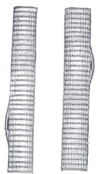


the muscles of the mouthMouthThe mouth is the first portion of the alimentary canal that receives food andsaliva. The oral mucosa is the mucous membrane epithelium lining the inside of the mouth....


the muscles of mastication


the lateral cervical muscles

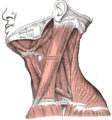
the supra-Suprahyoid musclesThe term suprahyoid refers to the region above the hyoid bone in the neck. The suprahyoid muscles include digastric, stylohyoid, geniohyoid, and mylohyoid...
and infrahyoid muscles

the deep muscles of the backBack- People :* Adam Back, British cryptographer* Charles Back, South African winemaker* Chris Back , Australian politician* Ernst Emil Alexander Back , German physicist* Frédéric Back , Canadian animator...

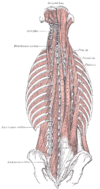
the muscles of the thoraxThoraxThe thorax is a division of an animal's body that lies between the head and the abdomen.-In tetrapods:...

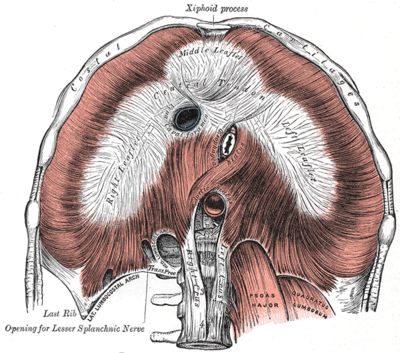
the muscles and fasciae of the abdomenAbdomenIn vertebrates such as mammals the abdomen constitutes the part of the body between the thorax and pelvis. The region enclosed by the abdomen is termed the abdominal cavity...
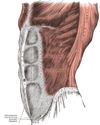


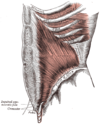
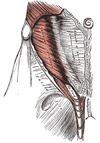





the muscles and fasciae of the pelvis


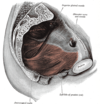
the muscles and fasciae of the perineumPerineumIn human anatomy, the perineum is a region of the body including the perineal body and surrounding structures...



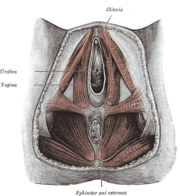
the muscles connecting the upper extremity to the vertebral columnVertebral columnIn human anatomy, the vertebral column is a column usually consisting of 24 articulating vertebrae, and 9 fused vertebrae in the sacrum and the coccyx. It is situated in the dorsal aspect of the torso, separated by intervertebral discs...

the muscles connecting the upper extremity to the anterior and lateral thoracic walls

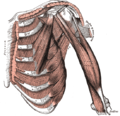
the muscles and fasciae of the shoulderShoulderThe human shoulder is made up of three bones: the clavicle , the scapula , and the humerus as well as associated muscles, ligaments and tendons. The articulations between the bones of the shoulder make up the shoulder joints. The major joint of the shoulder is the glenohumeral joint, which...

the muscles and fasciae of the forearmForearm-See also:*Forearm flexors*Forearm muscles...

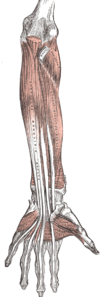



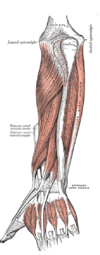

the muscles and fasciae of the handHandA hand is a prehensile, multi-fingered extremity located at the end of an arm or forelimb of primates such as humans, chimpanzees, monkeys, and lemurs...

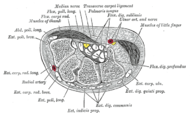

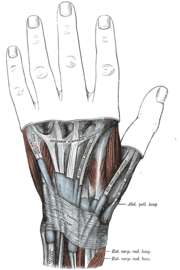


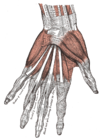

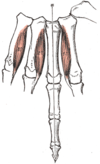
the muscles and fasciae of the iliac region

the muscles and fasciae of the thighThighIn humans the thigh is the area between the pelvis and the knee. Anatomically, it is part of the lower limb.The single bone in the thigh is called the femur...
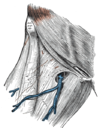





the muscles and fasciae of the legHuman legThe human leg is the entire lower extremity or limb of the human body, including the foot, thigh and even the hip or gluteal region; however, the precise definition in human anatomy refers only to the section of the lower limb extending from the knee to the ankle.Legs are used for standing,...




the fasciae around the ankleAnkleThe ankle joint is formed where the foot and the leg meet. The ankle, or talocrural joint, is a synovial hinge joint that connects the distal ends of the tibia and fibula in the lower limb with the proximal end of the talus bone in the foot...
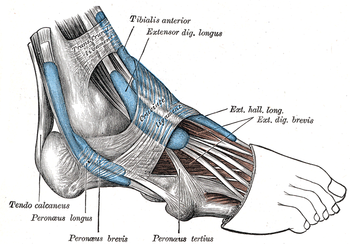

the muscles and fasciae of the footFootThe foot is an anatomical structure found in many vertebrates. It is the terminal portion of a limb which bears weight and allows locomotion. In many animals with feet, the foot is a separate organ at the terminal part of the leg made up of one or more segments or bones, generally including claws...






